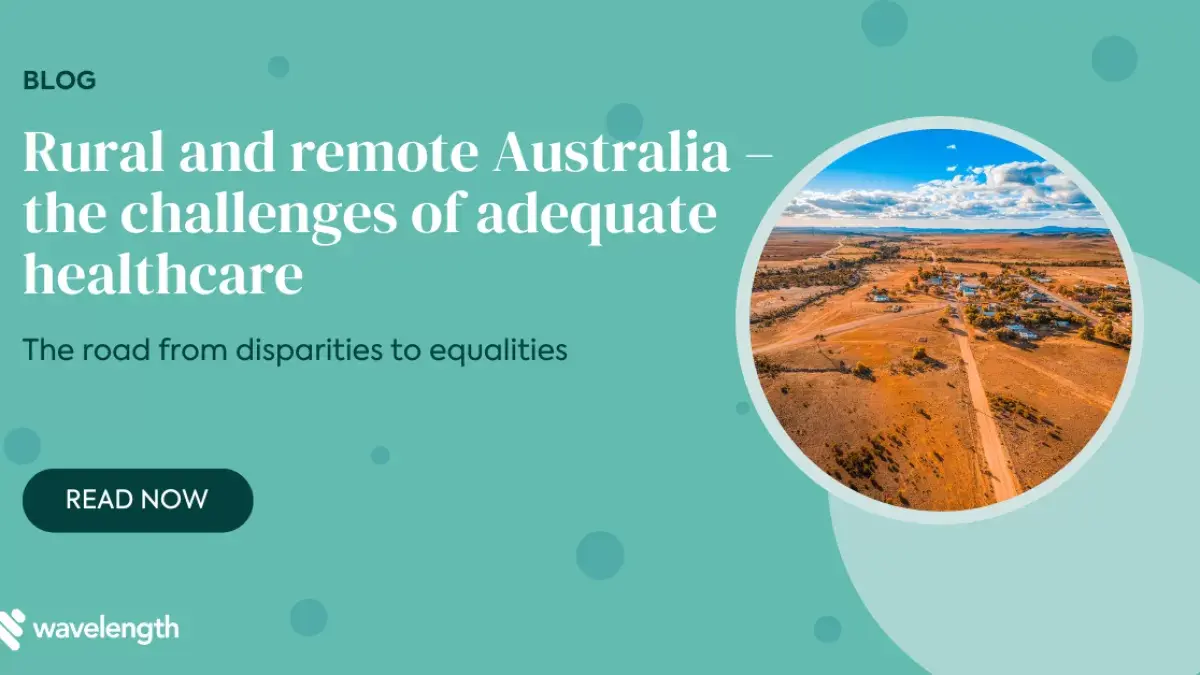- News
- Medical Careers
- 6 min read
Rural and remote Australia – the challenges of adequate healthcare
A summary of the RFDS deep-dive into Australia’s current and future rural and remote healthcare, including health disparities, current barriers, future projections and solutions.
- By: Admin
- September 27, 2024

In February 2023, the Royal Flying Doctor Service (RFDS) released a report, Rural and Remote Health Base Line 2022, addressing the current health status of rural and remote Australians.
Australia’s rural and remote population makes up 1.9% of the total population and suffers from poorer healthcare accessibility, workforce shortages, and an increased risk of disease and illness in comparison to metropolitan areas.
The need for an adequate number of healthcare professionals in these areas has always been a challenge, but in this post-COVID recovery phase where national shortages are expected within the next decade, the need has never been higher.
- Health disparities
There are major health disparities between populations of rural and metropolitan areas; significantly larger disparities are seen between Indigenous and non-Indigenous Australians. In fact, there is an approximate 14-year life expectancy difference between Indigenous and non-Indigenous people in remote/very remote Australia.
Life expectancy disparities are evidenced by the high disease and illness rates in rural Australia compared to metropolitan areas, with injury 2.4 times as high, infectious disease 2.3 times as high, and suicide 2 times as high. People in remote areas were 2.8 times more likely to be hospitalised, 2 times more likely to smoke daily, and 1.6 times more likely to consume alcohol at levels that exceed both single-occasion and lifetime risk guidelines.
- Barriers and challenges
Accessibility to healthcare services presents the biggest challenge to healthcare equality in Australia. The RFDS determined that 44,930 people in remote/very remote Australia had no access to any type of primary healthcare within a 60-minute drive from their homes. 208,247 people did not have access to nurse-led services, and 134,851 people did not have access to general mental health services.
Long travel distances and times, difficult terrains, poor transport, varying weather conditions, and maldistribution of the workforce are some of the main barriers to accessing healthcare.
- Future projections
The COVID-19 pandemic caused some significant damage to Australia’s healthcare, especially in the availability of care in rural and remote areas. It has also generated backlogs and delays, causing late diagnoses and late follow-ups, which in turn negatively impact health problems, recovery times and survival chances.
RFDS research forecasts that in the next decade, there will be significant shortages of essential health services in rural and remote areas. Projections indicate that in 2028 there will be:
- Less than a fifth of the number of general practitioners in remote Australia as compared to major cities
- A twelfth of the number of physiotherapists
- Half the number of pharmacists; and
- Only a third of the number of psychologists.
- Solutions and initiatives
Considering the pre-COVID healthcare system was inadequate, an attempt to return to this standard will result in even poorer outcomes. Instead, the RFDS made 5 recommendations:
- Ensure equal access to primary care through local planning, which includes ensuring reasonable access to primary healthcare within a 60-minute drive time.
- Create primary care plans for certain populations, locations, and at-risk populations.
- Establish an agreed definition of ‘reasonable access’, which should consider proximity, affordability, cultural appropriateness, availability, frequency, and mode of delivery.
- Improve data collection and integration.
- Implement a national compact on rural and remote health, ensuring efforts are coordinated to achieve the best results possible.
While the number of barriers and challenges to reaching adequate healthcare in rural and remote Australia is high, working towards the above recommendations and addressing additional health disparities are essential for better health outcomes and greater health equity across Australia. A substantially greater health workforce in rural and remote areas will be key to providing the necessary standard of services across the country.
Considering practising in rural and remote Australia?
Read this blog for more insights, and browse our current opportunities here.
Related Articles
-
 Sep 27
Sep 27Our Leadership: On the right wavelength
Our Executive Team members share their insights on the current market and how they see Wavelength making a difference in the future.
- Trends
- We are Wavies
- Admin
- 8 min read
-
 Aug 1
Aug 1The rewarding and fulfilling experiences of AMS locum work
This NAIDOC Week, Dr Kirsten Due shares her experiences providing essential healthcare and fostering meaningful connections in some of Australia’s most remote Indigenous communities.
- Medical Careers
- Admin
- 6 min read
-
 Sep 27
Sep 272023 Federal Budget – GP Recap
We explore the promised healthcare spending from this year’s budget announcement, which is designed as a foundation for future reform.
- News
- Medical Careers
- Admin
- 6 min read
Related Programs
-
 Sep 27
Sep 27Our Leadership: On the right wavelength
Our Executive Team members share their insights on the current market and how they see Wavelength making a difference in the future.
- Trends
- We are Wavies
- Admin
- 8 min read
-
 Aug 1
Aug 1The rewarding and fulfilling experiences of AMS locum work
This NAIDOC Week, Dr Kirsten Due shares her experiences providing essential healthcare and fostering meaningful connections in some of Australia’s most remote Indigenous communities.
- Medical Careers
- Admin
- 6 min read
-
 Sep 27
Sep 272023 Federal Budget – GP Recap
We explore the promised healthcare spending from this year’s budget announcement, which is designed as a foundation for future reform.
- News
- Medical Careers
- Admin
- 6 min read
